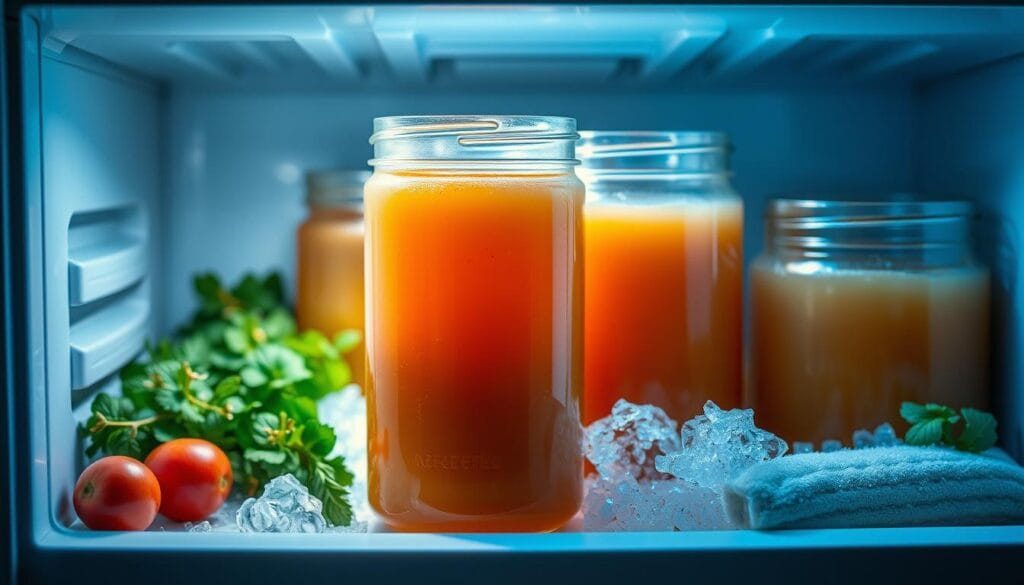How to Make Chicken Soup from Bones: Homemade and Healthy
As autumn arrives, nothing beats the warmth of homemade chicken soup. But did you know the secret to this comfort lies in the chicken bones? Yes, turning those bones into a rich, healthy broth is easy with a bit of time and patience.
Table of Contents
Understanding the Benefits of Homemade Bone Broth
Homemade bone broth is packed with nutrients. It’s simmered for hours, making it rich in collagen. This supports your joints and skin. Unlike regular chicken broth, bone broth is cooked longer to get more nutrients from the bones.
Nutritional Value and Health Benefits
Drinking 300ml of bone broth boosts your body’s amino acids. These are key for making collagen. Bone broth collagen can make your skin look better and improve joint health.
It also helps increase bone density in women after menopause. Plus, it can help build muscle and burn fat when you exercise.
Difference Between Regular Broth and Bone Broth
Bone broth is made differently than regular broth. It’s simmered for at least 6 hours, sometimes up to 24 hours. This long cooking time extracts more nutrients, like collagen and amino acids.
Cost-Effectiveness of Making Your Own
Homemade bone broth is affordable. You can use leftover chicken and vegetable scraps. This way, you save money and reduce waste.
It’s also great for many recipes. This makes it a smart and budget-friendly choice.
| Nutrient | Amount per Cup |
|---|---|
| Calories | 50 |
| Fat | 0.5 grams |
| Protein | 9 grams |
| Potassium | 280 milligrams |
| Sodium | 450 milligrams |
| Carbohydrates | 5 grams |
“Collagen in bone broth assists in inhibiting stress, enhancing mental clarity, promoting sleep, and potentially reducing signs of aging.”
Essential Ingredients for Chicken Soup from Bones
Making a tasty and healthy chicken soup from bones starts with the right ingredients. You need chicken bones, water, and some key aromatics. Let’s explore the must-haves for a top-notch homemade chicken soup.
First, you’ll need chicken bones. Use leftover chicken carcass or a package of chicken feet and necks. Roasting the bones for about 40 minutes helps cook the meat well.
Then, add water to the bones. After simmering the bones for 2-3 hours, you’ll get 1.5 to 2 liters of broth. This broth is the base of your chicken soup.
- Apple cider vinegar is key. It pulls out nutrients from the bones, making the broth richer.
- Salt and pepper are vital for seasoning. They enhance the chicken and aromatics’ natural flavors.
- Bay leaves add a warm, earthy taste to the soup.
- Aromatic veggies like onions, celery, carrots, and garlic boost the broth’s flavor.
- Fresh herbs like parsley and thyme add freshness.
With these ingredients, you’ll make a chicken soup that’s both tasty and healthy. Enjoy a comforting and nourishing meal from your kitchen!
Required Kitchen Equipment and Tools
To make delicious chicken soup from bones, you need the right tools. You’ll need a stock pot, an Instant Pot, or a slow cooker to simmer the bones. A mesh strainer or cheesecloth is key for separating the broth from solids.
For storing your soup, use glass containers like mason jars. But don’t freeze in glass jars as they might break. You’ll also need a slotted spoon and a skimmer to remove solids and impurities.
| Equipment | Purpose |
|---|---|
| Stock Pot | Large pot for simmering bones to make broth |
| Instant Pot | Pressure cooker for faster broth extraction |
| Slow Cooker | Slow cooking option for a more gradual broth release |
| Mesh Strainer | Separating liquid broth from solid bits |
| Glass Jars | Recommended storage containers (avoid freezing in glass) |
| Slotted Spoon | Removing larger solids from the broth |
| Skimmer | Removing impurities and fat from the surface of the broth |
With these tools, you’re ready to make tasty and healthy chicken soup from bones.
Preparing Your Chicken Bones for Soup
To make a rich, flavorful chicken soup, start with quality chicken bones. You can use a roasted chicken carcass or rotisserie chicken bones. First, remove any meat left on the bones and save it for later.
Roasting the raw chicken bones in the oven can add more flavor. Place the bones on a baking sheet and roast at 400°F for 20-30 minutes. This step makes the broth deeper and more savory.
- Gather your roasted chicken carcass or rotisserie chicken bones.
- Remove any remaining meat from the bones and set it aside for later use.
- If using raw chicken bones, roast them in the oven at 400°F for 20-30 minutes to enhance the flavor.
- Store the bones in an airtight container in the freezer until you’re ready to make your homemade chicken soup.
By preparing your chicken bones well, you’re on your way to a nourishing and tasty homemade chicken soup. It will surely warm your soul.
Step-by-Step Cooking Methods
There are many ways to make delicious chicken soup from bones. You can use the stovetop, slow cooker, or Instant Pot. Each method makes a tasty and healthy broth.
Stovetop Method
The stovetop is the traditional way to make chicken bone broth. Put chicken bones and aromatics like onions and carrots in a big pot. Cover them with cold water and heat it up.
Once it’s simmering, remove any impurities that float to the top. Then, lower the heat and let it simmer for at least 5 hours. You might need to add more water to keep the liquid level up. The longer it simmers, the more flavorful it gets.
Instant Pot Technique
The Instant Pot makes bone broth quickly without losing flavor. Just put in the chicken bones, veggies, and seasonings, and cover with water. Cook on high pressure for 120 minutes, then let it cool down naturally. This method gives you a clear, tasty broth in less time than the stovetop.
Slow Cooker Process
The slow cooker is great for making bone broth without much effort. Put everything in the slow cooker, cover it with water, and set it to low. Let it simmer for 12 to 24 hours, adding water as needed. This slow cooking makes the flavors blend well, creating a rich broth.
No matter the method, start with cold water and skim off any impurities. The longer it cooks, the more flavorful your broth will be.
“Homemade chicken bone broth is a kitchen staple that can be used in a variety of recipes, from soups and stews to sauces and rice dishes. The long simmering time extracts all the beneficial nutrients from the bones, making it a highly nutritious and versatile ingredient.”
Adding Aromatics and Vegetables
Make your homemade chicken soup taste better by adding aromatic vegetables and herbs. Onions, celery, carrots, and garlic add depth and complexity. Fresh herbs like parsley, thyme, and bay leaves bring an earthy, savory flavor.
Save your vegetable scraps in the freezer to reduce waste and boost nutrition. Carrot ends, celery leaves, and other trimmings can add flavor and nutrients to your next bone broth.
Try different vegetable and herbs for bone broth combinations for unique flavors. Roasting the aromatics before adding them can make the taste even richer. Adjust the amounts to your liking and let the flavors blend while simmering.
| Vegetable | Benefit |
|---|---|
| Onions | Adds depth and sweetness to the broth |
| Celery | Provides a subtle, savory flavor |
| Carrots | Contributes natural sweetness and nutrients |
| Garlic | Enhances the overall aroma and taste |

By adding vegetable scraps and herbs for bone broth thoughtfully, you can make a rich, flavorful chicken soup. It will nourish your body and soul.
Proper Straining and Clarifying Techniques
To get a clear, tasty bone broth, you need to strain and clarify it right. This process removes impurities and makes the broth clean and clear. It’s a joy to drink.
Removing Impurities
When simmering, impurities and foam will rise to the top. Skim them off with a spoon or ladle to keep the broth clear. This step removes unwanted particles and scum, making the broth clear.
Achieving Clear Broth
Once the bone broth is done simmering, it’s time to strain it. Use a fine-mesh strainer or cheesecloth to pour the broth through, leaving solids behind. For an even clearer broth, strain it again through a coffee filter or paper towel-lined sieve.
Cooling the broth and removing the solidified fat layer also clarifies the clear broth. This step gives you a clean, transparent soup base with great flavor and texture.
By using these straining bone broth methods, you’ll get a pure, crystal-clear broth. It’s the perfect base for delicious, nourishing soups and stews.
Storage and Preservation Tips
Proper storage and preservation are key to enjoying your homemade bone broth or soup. Whether you’re freezing freezing bone broth or storing homemade soup, these tips will help. They ensure your hard work lasts, and you can enjoy it for weeks.
After cooling, put your broth or soup in airtight containers or freezer-safe bags. It will last up to 5 days in the fridge. For longer storage, freeze it in smaller containers or ice cube trays. Frozen broth stays flavorful and nutritious for up to 3 months.
When freezing, leave some space in your containers for expansion. Label each container with the date it was made. This makes tracking easy. To thaw frozen broth, use the fridge or gently reheat it on the stovetop.
For even longer storage, try pressure canning. It can keep your broth or soup good for up to a year. Follow pressure canning guidelines for proper headspace and processing times. This method keeps nutrients and flavor locked in, so your broth or soup will taste fresh.

With these storage and preservation tips, you can enjoy your homemade broth or soup anytime. Take the time to store them properly. You’ll get delicious, wholesome meals for months.
Creative Ways to Use Your Bone Broth
Bone broth is full of nutrients and can make your cooking better in many ways. It’s not just for drinking; you can also use it in soups, stews, and sauces.
Base for Other Soups
Make a delicious chicken noodle soup by adding noodles, chicken, and veggies to your bone broth. It’s also great for cooking grains like quinoa or rice. Try it in vegetable soups or creamy mushroom bisque for a tasty twist.
Cooking Applications
Use bone broth to make your meals healthier and tastier. Replace water or stock with it in risottos, gravies, or when braising. It adds a silky, rich flavor to your dishes.
Bone broth isn’t just for savory dishes. It’s also great in summer drinks and desserts. Try it in popsicles, smoothies, or ice cream for something new. The options are endless with homemade bone broth.
Explore the many uses of bone broth in your cooking. Whether you drink it or use it in recipes, it’s a nutritious way to enhance your meals.
Troubleshooting Common Issues
Making homemade bone broth can be rewarding but comes with challenges. With a few simple tips, you can fix common issues and enjoy a delicious, nutritious broth.
Cloudy Broth
A cloudy broth usually means impurities haven’t been skimmed off. Skim the surface often during simmering to remove foam or scum. Avoid rapid boiling to prevent cloudiness.
Lack of Flavor
If your broth lacks flavor, try roasting the bones first. This extracts more gelatin and flavors. Or, cook it longer to let the flavors develop fully.
Broth That Won’t Gel
A gel-like consistency is a sign of quality broth. If it doesn’t gel, use more bones and joint-rich bones like chicken feet. This boosts gelatin content.
Excessive Fatty Broth
Too fatty broth? Chill it in the fridge until fat solidifies. Then, remove the hardened fat layer before reheating.
By tackling these common issues, your homemade bone broth will be delicious, nutritious, and clear of impurities. With a bit of troubleshooting, you’ll master your bone broth tips and fixing cloudy broth.
| Broth Type | Cooking Time |
|---|---|
| Fish | 1-2 hours |
| Chicken | 1-12 hours |
| Beef/Lamb/Pork | 2-24 hours |
Cooking times vary for different broths. Fish broth cooks in 1-2 hours, while beef, lamb, or pork broth can take up to 24 hours.
“Gelatinous broth is a visual indicator of a high gelatin content, which is beneficial for joint and bone health, among other conditions.”
Conclusion
Making chicken soup from bones is a rewarding process. It yields a nutritious, flavorful broth. This homemade version tastes better and is healthier than store-bought ones.
Using kitchen scraps and leftover bones makes it economical and sustainable. Homemade bone broth is versatile. It can be a base for other recipes or enjoyed on its own. It adds comfort, nutrition, and endless possibilities to any kitchen.
The benefits of homemade chicken soup are more than just taste. Bone broth is full of nutrients like collagen, gelatin, and amino acids. These support skin health, joint function, and gut lining.
It also has minerals like calcium, potassium, and magnesium. These minerals help keep bones strong and support a healthy metabolism.
Adding this traditional food to your diet offers many health benefits. It can reduce inflammation and joint pain. It also boosts the immune system and helps with weight management.
Chicken soup from bones has a long history and is significant worldwide. It’s not just a tasty meal but also a nourishing tradition. Try making homemade bone broth and see the nutritional benefits it can bring to your life.
FAQ
What are the benefits of homemade bone broth?
Homemade bone broth is packed with nutrients like collagen. It’s great for your joints. Plus, it’s cheaper and helps reduce waste by using leftover chicken and veggies.
What are the key ingredients for making chicken soup from bones?
You’ll need chicken bones, water, apple cider vinegar, salt, and pepper. Don’t forget bay leaves and veggies like onions, celery, carrots, and garlic.
What equipment is needed to make chicken soup from bones?
You’ll need a big stock pot, slow cooker, or Instant Pot. Also, a mesh strainer or cheesecloth for separating the liquid. Store it in glass containers like mason jars.
How should I prepare the chicken bones before making the broth?
Start with bones from a roasted or rotisserie chicken. Remove any meat. Roasting the bones in the oven for 20-30 minutes can make the broth taste better.
What are the different cooking methods for making chicken bone broth?
You can simmer it on the stovetop for 5 hours, use the Instant Pot for 120 minutes, or the slow cooker for 12-24 hours.
How can I enhance the flavor of the bone broth?
Add veggies like onions, celery, carrots, and garlic. Herbs like parsley, thyme, and bay leaves also help. Save veggie scraps in the freezer for future broths.
How do I ensure a clear, flavorful broth?
Skim off impurities that rise to the surface. Strain the broth through a fine-mesh strainer or cheesecloth. Cooling and removing solidified fat can make it clearer.
How should I store my homemade bone broth?
Cool the broth and store it in airtight containers in the fridge for up to 5 days. Freeze it in portion-sized containers or ice cube trays for up to 3 months.
How can I use the bone broth in my cooking?
Use it as a base for soups, stews, and sauces. It’s also good in risottos, gravies, or for braising meats and veggies. Enjoy it straight from a mug for a warm, nutritious drink.






